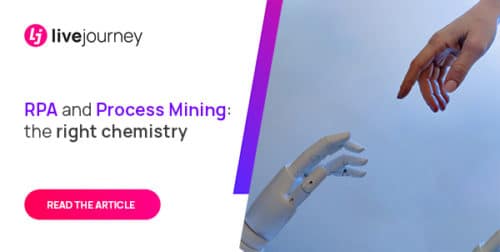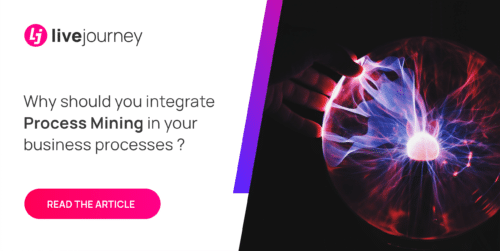process mining
All you need to know about Process Mining
What does Process Mining mean?
Process Mining enables companies to visualize precisely how their business processes are operated on a daily basis, to control them in real time and to optimize them.
Process Mining solutions automatically capture information from event logs in IT systems (ERP, WMS, CRM, etc.). In concrete terms, logs are based on facts and provide time-stamped information that allows you to track the status, progress and path taken by each unit in your processes in real time.
Still today collected and structured with difficulty by humans, data can now be processed simply and in real time thanks to Process Mining.

The management of your business processes by Process Mining is carried out in 4 phases
Process discovery
It provides a real-time visualization of the way your processes are operated: steps, times, anomalies, non-conformities, rework, etc. You have a first view of the real performance of your organization.
Process compliance
From the discovery phase, you have a first level of analysis. It is often a matter of comparing your theoretical processes with your real processes. What are the pain points of your processes? How do they evolve over time and space? etc.
Process automation
Which parts of my process are redundant, most frequently used and time consuming? In short, which steps would benefit from an investment in RPA? Process Mining then enables you to measure the performance of this automation.
Process prediction
What are the benefits of Process Mining?
According to an IDC market research, companies lose more than 20% of their annual revenues due to inefficient processes. Process Mining provides a solution to mitigate these losses. The benefits of this technology are numerous and depend on the processes being managed. In particular, it enables you to:
Have an end-to-end vision of all your processes in real time
Detect anomalies, identify root causes, and eliminate operational inefficiencies
Identify the best performing parts of your processes: suppliers, employees, etc.
Carry out automation actions and measure the ROI
What are the fields of application?

Address regulatory constraints (bank, P2P)
The banking environment, for example, is often constrained by security and compliance regulations. Process Mining allows you to highlight them easily. This also applies to procure-to-pay processes where the supplier’s payment is subject to late payment interest and this will be even more important with the new regulations to come (dematerialized invoices, real-time VAT declaration, etc.).
Respond to time constraints (supply chain, maintenance)
In supply chain, for example, Process Mining aims to optimize all the actors and key stages of the delivery process in order to reduce lead times and keep customer promises. This can also be applied to industrial maintenance processes: stopping certain equipment can represent a significant cost, the management of the maintenance process can reduce these latency times by optimizing the time and stages of maintenance.


Face operational efficiency issues (O2C, helpdesk)
In order-to-cash or even in helpdesk, Process Mining identifies rework, bottlenecks to better anticipate them or find different organizations to improve the efficiency of teams.
Raise customer satisfaction issues (customer experience)
The subscription or even moving process is very complex internally: the mining process allows to simplify these processes by highlighting recurrent anomalies and possible automations to make these processes more fluid and optimize them. (add part about customer journey)

Which results can be expected?
Real-time control of business processes allows for more efficient and engaging execution for employees. For example, the following results can be observed:
Reduction of costs
Gain of 1.2 days on 5 days initially in delivery time for an e-merchant for whom these delays are real competitive advantages and which represents a significant cost when they malfunction.
Improved transparency and performance
An industrial manufacturer wanted to have a real view of its payment times that it did not control. It was able to improve its compliance with its commitments by reducing its late payments by more than 20% in less than 6 months.
Improved customer experience
An online bank used Process Mining to identify that it was repeating the same task for 40% of its customers between two process steps. It was thus able to reduce its processing times by 30% and increase its customer satisfaction by 10 points.




